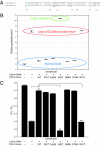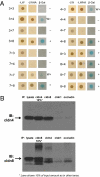Claudin-4 forms paracellular chloride channel in the kidney and requires claudin-8 for tight junction localization
- PMID: 20921420
- PMCID: PMC2964195
- DOI: 10.1073/pnas.1009399107
Claudin-4 forms paracellular chloride channel in the kidney and requires claudin-8 for tight junction localization
Abstract
Tight junctions (TJs) play a key role in mediating paracellular ion reabsorption in the kidney. The paracellular pathway in the collecting duct of the kidney is a predominant route for transepithelial chloride reabsorption that determines the extracellular NaCl content and the blood pressure. However, the molecular mechanisms underlying the paracellular chloride reabsorption in the collecting duct are not understood. Here we showed that in mouse kidney collecting duct cells, claudin-4 functioned as a Cl(-) channel. A positively charged lysine residue at position 65 of claudin-4 was critical for its anion selectivity. Claudin-4 was observed to interact with claudin-8 using several criteria. In the collecting duct cells, the assembly of claudin-4 into TJ strands required its interaction with claudin-8. Depletion of claudin-8 resulted in the loss of paracellular chloride conductance, through a mechanism involving its recruitment of claudin-4 during TJ assembly. Together, our data show that claudin-4 interacts with claudin-8 and that their association is required for the anion-selective paracellular pathway in the collecting duct, suggesting a mechanism for coupling chloride reabsorption with sodium reabsorption in the collecting duct.
Conflict of interest statement
The authors declare no conflict of interest.
Figures



Similar articles
-
Regulation of paracellular transport in the distal nephron.Curr Opin Nephrol Hypertens. 2012 Sep;21(5):547-51. doi: 10.1097/MNH.0b013e328355cb47. Curr Opin Nephrol Hypertens. 2012. PMID: 22691877 Free PMC article. Review.
-
Paracellular transport in the collecting duct.Curr Opin Nephrol Hypertens. 2016 Sep;25(5):424-8. doi: 10.1097/MNH.0000000000000253. Curr Opin Nephrol Hypertens. 2016. PMID: 27490784 Free PMC article. Review.
-
Interaction between Epithelial Sodium Channel γ-Subunit and Claudin-8 Modulates Paracellular Sodium Permeability in Renal Collecting Duct.J Am Soc Nephrol. 2020 May;31(5):1009-1023. doi: 10.1681/ASN.2019080790. Epub 2020 Apr 3. J Am Soc Nephrol. 2020. PMID: 32245797 Free PMC article.
-
The Cap1-claudin-4 regulatory pathway is important for renal chloride reabsorption and blood pressure regulation.Proc Natl Acad Sci U S A. 2014 Sep 9;111(36):E3766-74. doi: 10.1073/pnas.1406741111. Epub 2014 Aug 25. Proc Natl Acad Sci U S A. 2014. PMID: 25157135 Free PMC article.
-
Charge-selective claudin channels.Ann N Y Acad Sci. 2012 Jun;1257:20-8. doi: 10.1111/j.1749-6632.2012.06555.x. Ann N Y Acad Sci. 2012. PMID: 22671585
Cited by
-
Claudin-1, -2, -4, and -5: comparison of expression levels and distribution in equine tissues.J Vet Sci. 2016 Dec 30;17(4):445-451. doi: 10.4142/jvs.2016.17.4.445. J Vet Sci. 2016. PMID: 27030194 Free PMC article.
-
Conserved aromatic residue confers cation selectivity in claudin-2 and claudin-10b.J Biol Chem. 2013 Aug 2;288(31):22790-7. doi: 10.1074/jbc.M113.484238. Epub 2013 Jun 12. J Biol Chem. 2013. PMID: 23760508 Free PMC article.
-
LPCAT4 Knockdown Alters Barrier Integrity and Cellular Bioenergetics in Human Urothelium.Int J Mol Sci. 2022 Oct 6;23(19):11871. doi: 10.3390/ijms231911871. Int J Mol Sci. 2022. PMID: 36233185 Free PMC article.
-
Regulation of paracellular transport in the distal nephron.Curr Opin Nephrol Hypertens. 2012 Sep;21(5):547-51. doi: 10.1097/MNH.0b013e328355cb47. Curr Opin Nephrol Hypertens. 2012. PMID: 22691877 Free PMC article. Review.
-
Detection of Shared Balancing Selection in the Absence of Trans-Species Polymorphism.Mol Biol Evol. 2019 Jan 1;36(1):177-199. doi: 10.1093/molbev/msy202. Mol Biol Evol. 2019. PMID: 30380122 Free PMC article.
References
-
- Kurtz TW, Morris RC., Jr Dietary chloride as a determinant of “sodium-dependent” hypertension. Science. 1983;222:1139–1141. - PubMed
-
- Whitescarver SA, Ott CE, Jackson BA, Guthrie GP, Jr, Kotchen TA. Salt-sensitive hypertension: Contribution of chloride. Science. 1984;223:1430–1432. - PubMed
-
- Lifton RP, Gharavi AG, Geller DS. Molecular mechanisms of human hypertension. Cell. 2001;104:545–556. - PubMed
-
- Wall SM. Recent advances in our understanding of intercalated cells. Curr Opin Nephrol Hypertens. 2005;14:480–484. - PubMed
Publication types
MeSH terms
Substances
Grants and funding
LinkOut - more resources
Full Text Sources
Molecular Biology Databases

